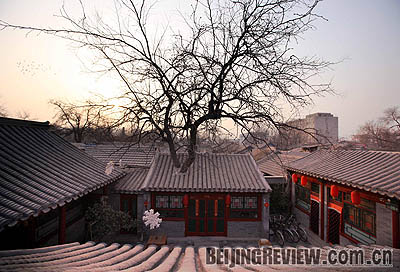|

BEIJING STYLE: The preservation of famous courtyard houses has become a growing public concern amid the building boom in the Chinese capital
Every month Beijing seems spiffier, hipper and more similar to other cosmopolitan cities. The magnificent 12th century Mongol capital, once known as Dadu, is undergoing tremendous renovations as China's economy booms.
Certainly, no one is complaining about the new subway lines and Terminal 3 at Beijing Capital International Airport. Residents like the ultramodern buildings displaying China's wealth and sophistication to the world, but many complain about the "Disneyification" of areas meant to attract tourists.
Beijing, as reconstructed throughout the 15th and 16th centuries, still remains the best example of traditional Chinese town planning despite the makeover. The real question revolves around whether Chinese culture will become extinct together with fast disappearing Chinese courtyards. Increasing pressure for urban development is causing Beijing to raze these ancient homes in favor of modern skyscrapers that yield higher profits and greater floor area ratios.
Throughout China, ancient homes had many similarities that cut across geography and economics with similar layouts for the rich and poor, both in earlier and later times. Although styles differed somewhat to accommodate the weather and terrain, certain materials and techniques, such as pounded earth foundations, timber framing, and the use of bricks and tiles, were ubiquitous. Furthermore, the ancient emphasis on orientation, layout and symmetry had retained its principal characteristics despite repeated foreign invasions-military, intellectual and spiritual-for thousands of years. Only recently has this ancient emphasis been ignored and discarded.
"Both location and building materials were thought to redirect beneficial energy for the dwellers," my colleague, He Shan, said. "Earth and wood, the two most common materials, are positive and auspicious. If you study a traditional home, you'll find that the bay numbers are always odd, because it's luckier. Much thought went into building Chinese homes."
She explained that houses were added on to systematically. For example, a three-bay house extension became a courtyard dwelling, with one extended family sharing this space.
"Of course, courtyard houses varied in size, depending on wealth and family taste, He said. "But generally these compounds had an inner courtyard and were built on a north-south axis. The door of the main building always faced south."
| 